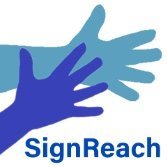-
BSL ForumVideo ChatFingerspelling
GameCreate an
AnimationPrint a
WordMake a
Word SearchFingerspelling
AlphabetOnline BSL
Course
-
Latest Posts
-
Hi my name is Emma and I am learning BSL from Australia. I have completed my Diploma of Auslan (Australian Sign Language) and have started learning BSL. If anyone is not a complete beginner and would like to practice that would be great! Australia is approx 9 hours ahead of London time...so hopefully we can find a suitable time:)
-
Hi, I am new to this forum. I am currently doing an online on-demand course along with a friend. I studied modern languages many years ago and am really interested to learn BSL - it is such an interesting and expressive language. I am also deaf in one ear (since early childhood) so am conscious that my hearing could worsen at some point.
-
By SignReach BSL · Posted
We are pleased to announce our new Level 1 course in British Sign Language from May onwards. This course will be held remotely via Zoom. The course will run every Saturday 10:00am to 13:00pm, from 4th May to 14th December 2024 (following the Hertfordshire school term) and is fully accredited by Signature. Enrolment is now open via our website: https://signreach.co.uk/level1-bsl/ All the course information and costs can also be found on the website. Please also have a look at our F -
Hello, I'm Sofie and I am hard of hearing I am learning BSL to communicate with more deaf and hard of hearing people.
-
By kerrylearnbsl · Posted
hi alison some of your reasons to learn are the same as mine this is like you say such a fascinating language i cant wait too learn more and hopefully put it into practice good luck on your bsl yourney -
By alison watts · Posted
Hi, nice to be here! I am learning bsl because I work supporting students at college and wish to be able to communicate better. Also this is a fascinating language to learn and I am just really interested! -
By archilawson · Posted
Nursery rhyme video for Signing Animation and Story, which increase language development, cultural connection, and speaking with engaging animations and relaxing tunes. which all are in one application. -
By Xenia Lopez · Posted
I have always been really passionate about languages, and a few years ago I came across Christine Sun Kim Ted "The enchanting music of sign language" and it sparked my curiosity about SL. At that moment I knew nothing about it, I genuinely felt so surprised "how can it be that such a fascinating form of communication is so forgotten by the hearing folks???" A few years later after that (I had been working in improving and mastering my English), and especially since I am moving to Scotland i
-
-
Fingerspelling Scoreboard
(top 10 - past 24hrs)
-
Fingerspelling Animation Maker



Recommended Posts
Create an account or sign in to comment
You need to be a member in order to leave a comment
Create an account
Sign up for a new account in our community. It's easy!
Register a new accountSign in
Already have an account? Sign in here.
Sign In Now